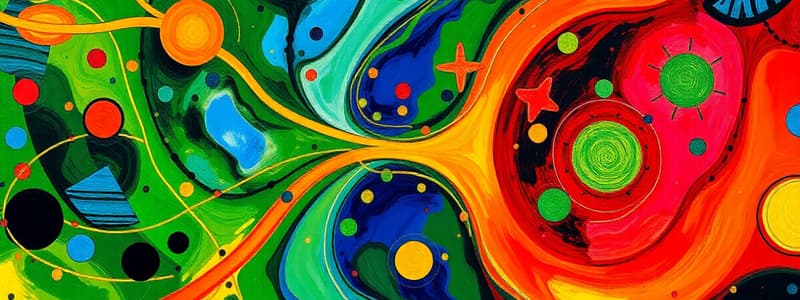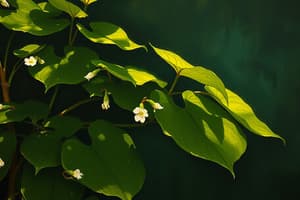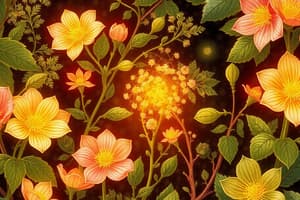Podcast
Questions and Answers
What is the general equation of photosynthesis?
What is the general equation of photosynthesis?
CO2 + H2O + light energy → C6H12O6 + O2 + H2O
Which of the following organisms are considered photoautotrophs?
Which of the following organisms are considered photoautotrophs?
- Fungi
- Green plants (correct)
- Humans
- Bacteria
Heterotrophs can make organic molecules from inorganic sources.
Heterotrophs can make organic molecules from inorganic sources.
False (B)
What organelles in plants and algae carry out photosynthesis?
What organelles in plants and algae carry out photosynthesis?
What is the primary pigment involved in photosynthesis?
What is the primary pigment involved in photosynthesis?
Match the following phases of photosynthesis with their characteristics:
Match the following phases of photosynthesis with their characteristics:
What are the main products of the light reactions in photosynthesis?
What are the main products of the light reactions in photosynthesis?
The electromagnetic spectrum includes visible light.
The electromagnetic spectrum includes visible light.
Why do leaves appear green?
Why do leaves appear green?
Flashcards
Heterotroph
Heterotroph
An organism that obtains energy by consuming other organisms.
Autotroph
Autotroph
An organism that makes its own food from inorganic sources.
Photoautotroph
Photoautotroph
An autotroph that uses light energy for photosynthesis.
Photosynthesis
Photosynthesis
Signup and view all the flashcards
Chloroplast
Chloroplast
Signup and view all the flashcards
Chlorophyll
Chlorophyll
Signup and view all the flashcards
Light Reactions
Light Reactions
Signup and view all the flashcards
Calvin Cycle
Calvin Cycle
Signup and view all the flashcards
Stroma
Stroma
Signup and view all the flashcards
Thylakoid
Thylakoid
Signup and view all the flashcards
Grana
Grana
Signup and view all the flashcards
Photosynthetic Pigments
Photosynthetic Pigments
Signup and view all the flashcards
Electromagnetic radiation
Electromagnetic radiation
Signup and view all the flashcards
Photon
Photon
Signup and view all the flashcards
Pigments absorb wavelengths
Pigments absorb wavelengths
Signup and view all the flashcards
Electromagnetic spectrum
Electromagnetic spectrum
Signup and view all the flashcards
Mesophyll
Mesophyll
Signup and view all the flashcards
Stomata
Stomata
Signup and view all the flashcards
Vascular tissue
Vascular tissue
Signup and view all the flashcards
ATP
ATP
Signup and view all the flashcards
NADPH
NADPH
Signup and view all the flashcards
Chlorophyll a
Chlorophyll a
Signup and view all the flashcards
Chlorophyll b
Chlorophyll b
Signup and view all the flashcards
Carotenoids
Carotenoids
Signup and view all the flashcards
Study Notes
Trophic organization
- Heterotrophs must consume organic molecules to survive
- Autotrophs produce their own organic molecules from inorganic sources
- Photoautotrophs use light as energy
- Green plants, algae, and cyanobacteria are photoautotrophs
Photosynthesis
- Green plant leaves are where photosynthesis occurs.
- Photosynthesis converts light energy to chemical energy (carbohydrates).
- Overall formula: CO2 + H2O + light energy → C6H12O6 + O2 + H2O
- Carbon dioxide (CO2) is reduced
- Water (H2O) is oxidized
- The biosphere is driven by photosynthesis.
- Photosynthesis replenishes organic molecules used by cells.
Chloroplast
- Chloroplasts are the site of photosynthesis in plants and algae.
- They contain green pigment called chlorophyll.
- Most photosynthesis occurs in the mesophyll of leaves.
- Stomata allow carbon dioxide to enter and oxygen to exit the leaf.
- Water is transported from roots to the stem via vascular tissue.
Chloroplast anatomy
- Carbon dioxide (CO2) and water diffuse into the chloroplast.
- The stroma is the fluid inside the chloroplast. It contains enzymes that convert carbon dioxide into carbohydrates.
- Thylakoids are the flattened, sac-like membranes within the stroma. They are the sites of photosynthesis.
- Thylakoids are stacked in groups called grana.
- Chlorophyll and other pigments in the thylakoid membranes absorb solar energy for photosynthesis.
2 stages of photosynthesis
-
Two sets of reactions are involved in photosynthesis:
-
The light reactions are the first stage of photosynthesis and occur in the thylakoid membranes of the chloroplasts. During this process, chlorophyll, the green pigment found in these membranes, captures sunlight. This solar energy is then transformed into chemical energy in the form of adenosine triphosphate (ATP) and nicotinamide adenine dinucleotide phosphate (NADPH). The energy captured is used for the subsequent stage of photosynthesis, while water molecules are split, releasing oxygen as a byproduct.
-
Chlorophyll absorbs light energy and energizes electrons.
-
These energized electrons move through an electron transport system.
-
Energy is captured and used to produce ATP.
-
Energized electrons are also used to reduce NADP+ to NADPH.
-
Overall, light energy is converted into ATP and NADPH.
-
Calvin Cycle (Dark Reaction):
- Carbon dioxide (CO2) is reduced to a carbohydrate within the stroma.
- This reduction process requires ATP and NADPH.
-
Light energy
- Light is a form of electromagnetic radiation.
- The electromagnetic spectrum includes visible light, a range of wavelengths from short to long.
- Light also behaves as particles called photons.
- Shorter wavelengths have more energy.
Photosynthetic pigments
- They absorb specific wavelengths of light and reflect others.
- Leaves appear green because they reflect green wavelengths.
- Light absorption excites electrons to higher energy levels.
- The specific wavelengths absorbed by a pigment are determined by the energy required to excite electrons.
- Excited electrons are unstable and release energy as heat and light.
- Captured light energy can be transferred to other molecules for cellular work.
Pigments
- Photosynthetic pigments absorb light energy.
- Pigments in chloroplasts include chlorophyll a, chlorophyll b, and carotenoids.
- Chlorophyll a and b are important for photosynthesis and absorb violet, blue, and red light.
- Carotenoids are important for fall color changes when chlorophyll degrades.
Studying That Suits You
Use AI to generate personalized quizzes and flashcards to suit your learning preferences.




